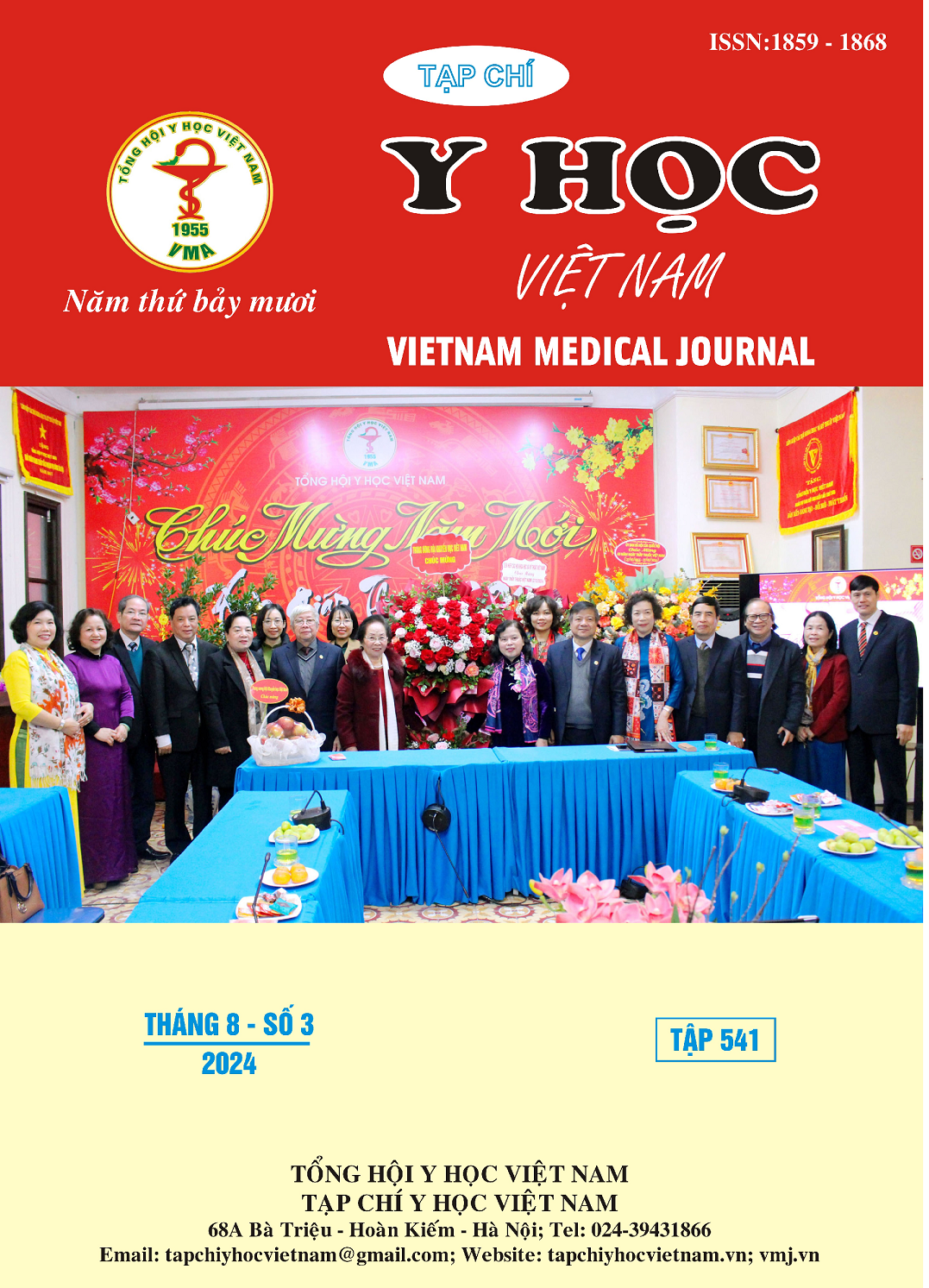BACTERIAL ETIOLOGY OF VENTILATION-ASSOCIATED PNEUMONIA IN THE SURGICAL INTENSIVE CARE UNIT OF NGHE AN GENERAL FRIENDSHIP HOSPITAL
Main Article Content
Abstract
Objective: Identify the bacterial causes of ventilator-associated pneumonia at the Department of Surgical Intensive Care of Nghe An General Friendship Hospital from 2022 to 2023. Subjects and methods: a cross-sectional descriptive study on 110 patients diagnosed with ventilator-associated pneumonia from October 2022 to October 2023 at the Department of Surgical Intensive Care, Nghe An General Friendship Hospital. Results: The positive sputum culture rate was 82.7%. Acinetobacter baumannii accounts for the highest proportion at 43.1%, followed by Klebsiella pneumoniae accounts for 25.5%, Pseudomonas aeruginosa accounts for 13.7%, and Escherichia coli accounts for 3.9%. Gram-positive bacteria are Staphylococcus aureus, accounting for 7.8%. A. baumannii is resistant to many commonly used antibiotics today at a very high rate, > 80% resistant to piperacillin/tazobactam antibiotics, 3rd - 4th generation cephalosporins, and carbapenems. K.pneumoniae strains are resistant to β-lactam antibiotics at a rate of more than 75%, and> 90% are resistant to 3-4 generation cephalosporins. P. aeruginosa is > 75% resistant to most antibiotics. All Staphylococcus aureus strains were resistant to methicillin, 100% sensitive to vancomycin and linezolid, utterly resistant to Penicillin G. Escherichia coli was resistant to quinolone at a rate of > 90%, 62.5% resistant to Ceftazidime, 100% resistant to cefoperazone, cefuroxime, piperacillin/tazobactam, amoxicillin/clavulanic acid. Escherichia coli is also sensitive to Amikacin at a rate of 62.5%. Conclusion: The leading causes of ventilator-associated pneumonia are A.baumannii and K. pneumoniae. Pathogenic bacterial strains are resistant to many antibiotics at high rates.
Article Details
Keywords
ventilator-associated pneumonia, surgical intensive care, Nghe An General Friendship Hospital
References
2. Hoàng Khánh Linh (2018). Nghiên cứu đặc điểm viêm phổi liên quan thở máy tại Khoa Hồi sức tích cực Bệnh viện Bạch Mai giai đoạn 2017-2018. Luận văn chuyên khoa cấp II. Trường Đại học Y Hà Nội.
3. Nguyễn Trung Kiên, Lê Đăng Mạnh, Nguyễn Chí Tâm (2019), “Tỷ lệ viêm phổi liên quan thở máy ở bệnh nhân chấn thương sọ não nặng tại Bệnh Viện Quân Y 103 và tính kháng kháng sinh của các vi khuẩn”, Tạp Chí Y Dược Học Quân Sự, phụ bản số 7, tr.80-88.
4. Trần Hữu Thông, Nguyễn Đạt Anh, Đặng Quốc Tuấn (2012). Nghiên cứu căn nguyên gây viêm phổi liên quan thở máy tại khoa Cấp cứu và Hồi sức tích cực bệnh viện Bạch Mai. Y học Việt Nam, 2: 65 –69.
5. Golia S, K T S, C L V. Microbial profile of early and late onset ventilator associated pneumonia in the intensive care unit of a tertiary care hospital in bangalore, India. J Clin Diagn Res JCDR. 2013;7(11): 2462-2466. doi:10.7860/JCDR/ 2013/6344.3580
6. Đỗ Danh Quỳnh (2019). Đặc điểm lâm sàng viêm phổi liên quan đến thở máy ở bệnh nhân chấn thương và mức độ kháng kháng sinh của vi khuẩn gây bệnh. Luận văn bác sĩ chuyên khoa Cấp II. Trường Đại học Y Hà Nội.
7. Trịnh Thị Hoàng Anh (2020), “Đánh giá vi khuẩn và tình trạng kháng kháng sinh của các loại vi khuẩn gây viêm phổi liên quan thở máy tại Đơn Vị Hồi Sức Ngoại Khoa Bệnh Viện Bạch Mai Hà Nội”, Luận văn Thạc Sĩ Y Học, Đại Học Y Hà Nội.
8. Trần Hữu Thông (2014). Nghiên cứu căn nguyên gây viêm phổi liên quan đến thở máy và hiệu quả dự phòng biến chứng này bằng phương pháp hút liên tục hạ thanh môn, Luận án tiến sỹ y học, Trường Đại học Y Hà Nội.
9. Trần Công Tiến (2016). Đánh giá mức độ nhạy cảm với kháng sinh của vi khuẩn gây viêm phổi liên quan đến thở máy. Luận văn Thạc sĩ Y học. Trường Đại học Y Hà Nội.


